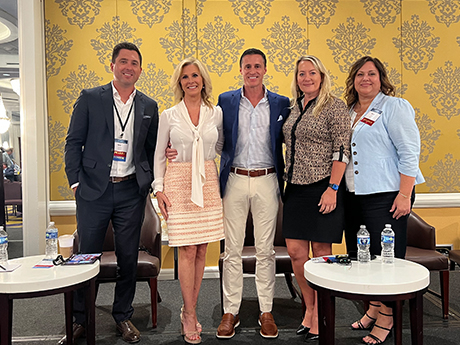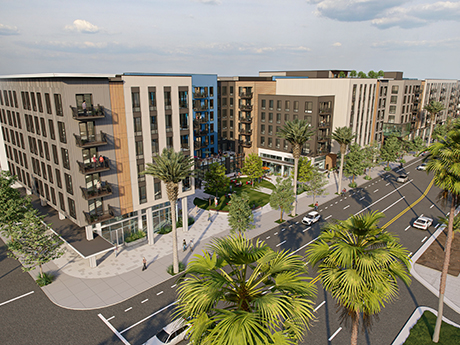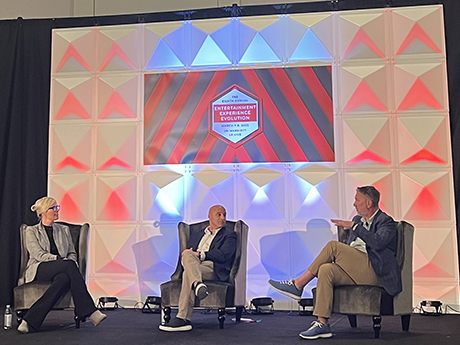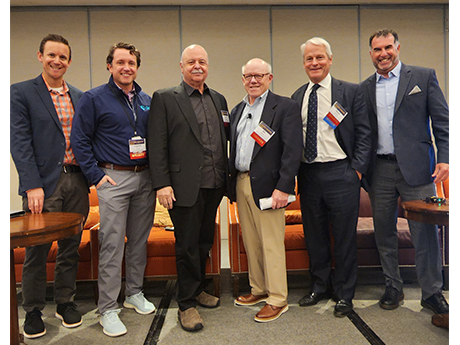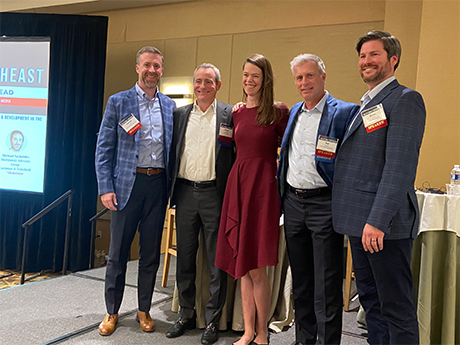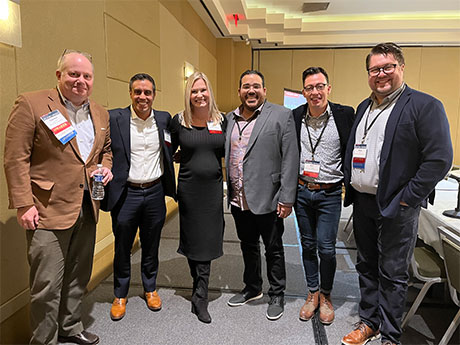Suburban markets in the Carolinas are the big winners in the current multifamily landscape, both from a new development and rent growth perspective, according to the various panelists at the InterFace Carolinas Multifamily conference. Hosted by InterFace Conference Group and Southeast Real Estate Business, the annual event took place on May 25 at the Hilton Charlotte Uptown hotel. At the end of the leasing and operations panel, moderator Mike Susen, senior director of real estate at Greystar, asked the property managers on stage if they could manage any product type in any Carolinas market, which they would choose. The consensus was their dream assignments lie in the suburbs. “Let’s do mid-rise suburbs, something out toward Matthews or the Mint Hill area,” said Amanda Kitts, senior vice president of property management at Northwood Ravin, referring to the suburbs of Charlotte. “I’d want to do product that those markets haven’t seen yet.” “Suburban product is still really strong right now,” added Bob Moore, co-founder and CEO of FCA Management LLC. “Tertiary markets are going to surprise you. You’ll see opportunities to do some deals where there has been a lot lower supply.” Property managers are keen to handle suburban communities because those …
Conference Coverage
Affordable HousingBuild-to-RentConference CoverageFeaturesMultifamilyNorth CarolinaSingle-Family RentalSouth CarolinaSoutheastSoutheast Feature Archive
Interstate 85 Corridor Industrial Markets Aren’t Overbuilt Yet, Say InterFace Panelists
by John Nelson
Interstate 85 traverses through the heart of the Southeast, the fastest-growing region in the United States by way of population. The southern terminus of the 666-mile interstate is in Montgomery, Ala., home of the mega Hyundai Motor Manufacturing Alabama plant, and it travels north to just shy of Richmond, Va., the site of North America’s first LEGO factory. Along the way, I-85 connects through Atlanta and the Carolinas markets of Greenville-Spartanburg, Charlotte, Greensboro and Raleigh-Durham. These I-85 Corridor markets have seen their fair share of industrial development in recent years, so much so that for the first time this cycle, some experts are worried about overbuilding. Steven McGee, vice president of Southeast development at Rockefeller Group, said that half of the nation’s population growth has been coming to the Southeast region, and that faucet isn’t expected to be shut off anytime soon. “America is getting bigger, and half of that growth is occurring in three or four states,” said McGee. “I don’t see any real structural elements that are stopping that growth. It’s a challenge on the timing [for industrial deliveries], but in almost every market we have record vacancy. We have very few options for occupiers coming into the …
Wellness Amenities, Updated Technology are Top Priorities for Student Housing Projects, Says InterFace Panel
by Katie Sloan
With some markets today saturated with new student housing development, differentiating your project has become of paramount importance. One of the primary ways of doing that is by keeping in touch with the wants and needs of today’s student — and specifically a community’s surrounding demographic. This was discussed at length during the kick-off panel for InterFace Student Housing, which took place in April in Austin, Texas. In preparation for the panel — titled “What’s Trending in New Development: A Survey of 2023 New Deliveries & How Developers and Operators Aim to Address the Needs and Wants of Today’s Students” — a survey was sent out by uForis to 500 Gen Z students ranging in age from 18 to 24 years old regarding their wants, needs and preferences when looking for their next place of residence. The primary takeaways from this year’s survey were the impact of regional differences due to weather and year-round use of amenities; the shift away from entertainment towards health and wellness for shared amenity spaces; and the increasing impact of tech offerings like digital touring and online leasing, according to panel moderator TJ Chambers, owner and founder of Chambers Real Estate Advisors. “During pre-development at …
AUSTIN, TEXAS — Experts in the student housing industry are bullish on the outlook for the upcoming academic year, citing the strong performance and outstanding fundamentals of the sector. At the recent 15th annual InterFace Student Housing conference in Austin, industry professionals from around the country convened at the JW Marriott downtown to share insights and discuss industry trends. The first full day of the conference kicked off with the ‘Power Panel’ session, where a consortium of high-level executives provided their outlook for the year ahead. “Evidenced once again by a packed house in this room, the sector is popping,” began moderator Peter Katz, executive director of Institutional Property Advisors. “As we continued to experience unprecedented, off-the-charts asset operations in 2022 and through the first quarter of this year, while simultaneously seeing the most mercurial capital markets we’ve seen in years, we have now statistically proven that the industry is not only recession resilient but pandemic resilient.” The real estate industry has been under a lot of pressure since the summer of 2022 as a result of the rapid rise in the cost of debt, which has created challenges as it pertains to valuing assets. “The recent quarter-point rise has …
LOS ANGELES — Whitney Livingston had a question for those in attendance at the annual Entertainment Experience Evolution conference in Los Angeles: Which user — food halls or restaurants — are more beneficial to driving traffic at retail properties? By show of hands, most attendees said food halls. Livingston, president of Centennial REC, was moderating the event’s “Fireside Chat: What’s Better for Traffic, Food Hall or Restaurants?” panel at the JW Marriott LA Live. Each of the categories was embodied in the form of a panelist. Representing food halls was Michael Morris, CEO of the aptly named Food Hall Co., with Rich Renninger, SVP and chief development officer of Darden Restaurants, weighing in from the perspective of more traditional, full-service restaurants. Despite what the name of the panel might suggest and Livingston’s opening poll, the dialogue that emerged between Renninger and Morris did not take on the shape of a debate so much as a conversation that illustrated that, for all their distinctions, there are many commonalities between the two types of food-and-beverage users. Ultimately, the panelists revealed that though food halls and full-service restaurants may take different paths, there is one shared recipe for success: creating a robust customer …
Sports-Anchored Entertainment Districts Deliver Experiences Well Beyond Athletics, Say EEE Panelists
LOS ANGELES — As large-scale entertainment districts that are centered around professional sports teams pop up around the country, operators of these developments are realizing that their ability to draw traffic, generate revenue and deliver meaningful experiences goes well beyond the diamond, arena or gridiron. After all, the average professional sports season only lasts about six months — assuming the team qualifies for the postseason — and only half the games are played at home. Given the scope of these projects, in terms of their vast physical footprints and tremendous manpower needed to operate the wide variety of concepts they house, it follows that sports-anchored entertainment districts cannot rely on athletics alone to be successful. At the Entertainment Experience Evolution that took place in Los Angeles in early March, a panel of developers and operators with extensive experience in sports-anchored entertainment districts provided concrete examples of how to achieve this objective. Hosted by Shopping Center Business, the flagship publication of Atlanta-based France Media, the event drew more than 500 people in its eighth annual iteration. Rob Hunden, president and CEO of Hunden Strategic Advisors, a Chicago-based consulting firm for destination-style commercial projects, moderated the discussion. Pioneering Examples John Moncke, a …
By Nellie Day LOS ANGELES — The advice offered by a panel of developers at InterFace Seniors Housing West, held Feb. 2 at the Omni Los Angeles, mirrors the advice many would give to their senior residents. Namely, “stay active and stay creative.” But these verbs take on a slightly different meaning when you’re talking about the smartest plays for seniors housing developers during a time in which key economic conditions are changing. “The smarter operators and developers have been developing pipelines,” said panelist Paul Mullin, principal at Flatiron Development Group. “The key is momentum. Keep momentum going. Keep the pipeline going. Don’t stop because bankers aren’t lending. We’ll all get out of this; it’s just a short-term issue we have to overcome.” The issue of the current market conditions may be short term, but it’s also multifaceted, as David Waite, partner at Cox, Castle & Nicholson, pointed out. “The challenges are real,” he said. “You’ve got the spread between bid and ask and a rising-cap-rate environment. To go in and buy an asset today in this market is super challenging because you know it’s going in the wrong direction in terms of the valuation.” The solution, according to Waite, …
Against increasingly turbulent macroeconomic conditions, capital sources in both the debt and equity markets are being pickier about which multifamily deals they finance or invest in, with higher required rates of return (RRR) emerging as the symbol of this newfound selectivity. The macroeconomic deck is indeed stacked against capital sources. Borrowing costs have quintupled over the last eight months as the Federal Reserve has waged war on inflation, rattling off seven rate hikes for an aggregate increase of 425 basis points. Prices of key construction materials continue to fluctuate wildly as labor issues, both domestic and abroad, continue to entangle global supply chains. But lenders and investors can only sit on the sidelines for so long. To hedge their bets against market conditions beyond their control, many capital sources in the multifamily space are only giving serious consideration to deals and projects in which the path to a certain rate of return — or exit cap rate — is clear and plausible. The movement in RRR that multifamily owners and developers are facing from their capital partners formed a core part of the discussion at the 13th annual InterFace Multifamily Southeast conference. Hosted by Atlanta-based France Media, the event took …
Partnership, Early Planning Integral to Multifamily Project Success, Say Interface Design Panelists
by Jeff Shaw
ATLANTA — This year has been a tumultuous one for multifamily construction. Between rising interest rates, fluctuating supply lines, costs of materials and difficulties procuring labor, developer confidence in new multifamily starts is faltering as work on current projects is beginning to slow. “In this market, it’s so hard to stay abreast of all of the changes that are happening,” said Cara Frost, director of preconstruction at Juneau Construction, which is based in Atlanta. “And that has led to a more design-assist approach on our end.” Frost’s comment came during the “What to Look for in Architecture, Design and Construction Trends in 2023” panel at the 13th annual InterFace Multifamily Southeast on Dec. 1. France Media hosted the event at the Westin Buckhead hotel in Atlanta. There were approximately 325 conference attendees. Joe Martinez, president of Atlanta-based real estate development and investment firm Vida Cos., moderated the panel. Speakers discussed the challenges they are currently facing and emphasized the importance of collaboration and transparency early in the process of a project. “There are three buckets — budget, time and quality — and right now, you get to be really good at two of those things,” remarked Josh Kassing, vice president …
Interest Rate Volatility Will Slow Multifamily Investment Activity in 2023, Says InterFace Panel
by John Nelson
ATLANTA — A lot can happen in a year. This time a year ago, the 10-year Treasury yield was at 1.489 percent, the federal funds rate was at a range of 0 to 0.25 percent and SOFR was at 0.05 percent. As of this writing, those three benchmark interest rates are at 3.527 percent, 3.75 to 4 percent and 3.82 percent, respectively — none of which are within 200 basis points from a year ago. Debt capital has become decisively more expensive, and officials at the Federal Reserve are signaling that more rate hikes are coming. For the U.S. multifamily sector, the result is that investors are increasingly becoming “pencils down” until interest rates find their footing. “We haven’t had much [investment] sales volume, as you can imagine, in the third or fourth quarter,” said Bennett Sands, managing development director at Wood Partners, an Atlanta-based apartment developer. “Looking ahead, our sales volume in 2023 will be down 50 percent [from 2022], if we’re lucky.” “It has been pretty quiet the past few months, and we expect that to continue for the next few months as well,” added Andrew Zelman, vice president of acquisitions at GID, a multifamily and mixed-use developer …


